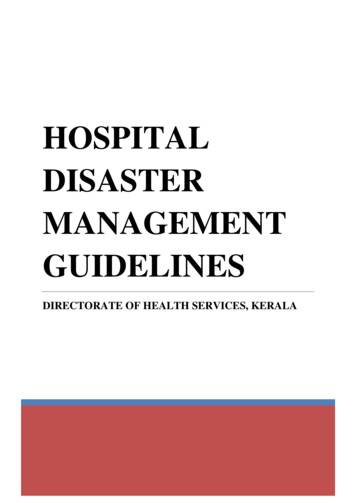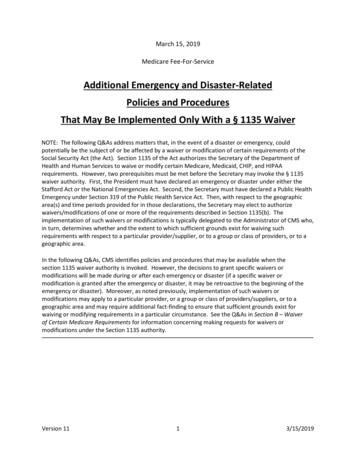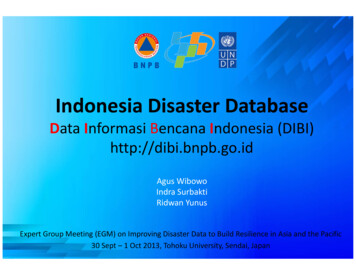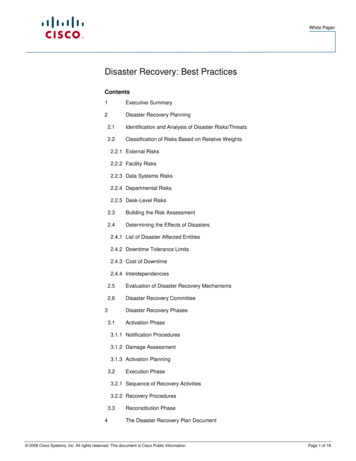
Transcription
Final ReportASSURE A28: Disaster Preparedness and Response UsingUASAttachment 8 – Concept of Operations (CONOPS) for VolcanoJune 1, 2022
NOTICEThis document is disseminated under the sponsorship of the U.S. Department of Transportation inthe interest of information exchange. The U.S. Government assumes no liability for the contentsor use thereof. The U.S. Government does not endorse products or manufacturers. Trade ormanufacturers’ names appear herein solely because they are considered essential to the objectiveof this report. The findings and conclusions in this report are those of the author(s) and do notnecessarily represent the views of the funding agency. This document does not constitute FAApolicy. Consult the FAA sponsoring organization listed on the Technical Documentation page asto its use.
LEGAL DISCLAIMERThe information provided herein may include content supplied by third parties. Although the dataand information contained herein has been produced or processed from sources believed to bereliable, the Federal Aviation Administration makes no warranty, expressed or implied, regardingthe accuracy, adequacy, completeness, legality, reliability or usefulness of any information,conclusions or recommendations provided herein. Distribution of the information contained hereindoes not constitute an endorsement or warranty of the data or information provided herein by theFederal Aviation Administration or the U.S. Department of Transportation. Neither the FederalAviation Administration nor the U.S. Department of Transportation shall be held liable for anyimproper or incorrect use of the information contained herein and assumes no responsibility foranyone’s use of the information. The Federal Aviation Administration and U.S. Department ofTransportation shall not be liable for any claim for any loss, harm, or other damages arising fromaccess to or use of data or information, including without limitation any direct, indirect, incidental,exemplary, special or consequential damages, even if advised of the possibility of such damages.The Federal Aviation Administration shall not be liable to anyone for any decision made or actiontaken, or not taken, in reliance on the information contained herein.
TABLE OF CONTENTSATTACHMENT 8 - CONCEPT OF OPERATIONS (CONOPS) FOR VOLCANO . 31.1Concept of Operation (CONOP) . 51.2CONOP Quad Chart . 61.3Situation . 81.4Systems. 91.5Mission . 101.6Execution . 121.7Administration & Logistics . 151.8Command & Signal . 201.9Supplementary appendices to accompany CONOP . 20
TABLE OF ACRONYMSAGLAbove Ground LevelARTCCAir Route Traffic Control CenterAVOAlaska Volcano ObservatoryBVLOSBeyond Visual Line of SightCONOPConcept of OperationDAADetect and AvoidDOIDepartment of the InteriorEOElectro-OpticalFAAFederal Aviation AdministrationGCSGround Control StationGEOJSONGeographic JavaScript Object NotationHDHigh definitionHDF5Hierarchical Data FormatHzHertzIFRInstrument Flight RulesJPEGJoint Photographic Experts GroupKMLKeyhole Markup LanguageNASNational Airspace SystemNOTAMNotice to AirmenNWSNational Weather ServiceORAOperational Risk AssessmentPICPilot in CommandRHRelative HumidityRTBReturn to BaseSfMStructure from MotionSGISpecial Government InterestSHPShape fileSOSCSystem Operations Support CenterTFRTemporary Flight RestrictionTIFFTag Image File FormatUAFUniversity of Alaska Fairbanks
UASUncrewed/Unmanned Aircraft SystemUSGSUnited States Geological SurveyVAACVolcanic Ash Advisory CenterVFRVisual Flight RulesVLOSVisual Line of SightVOVisual ObserverVTOLVertical Take-Off and Landing
ATTACHMENT 8 - CONCEPT OF OPERATIONS (CONOPS) FORVOLCANOLead organization will demonstrate that the CONOP has been reviewed. The CONOP will beaccepted if the document contains sufficient information to proceed to an Operational RiskAssessment (ORA). The CONOP is to be submitted by the lead organization for the mission.Approval by (Name/Org)TitleDateApprove Digital SignatureThis CONOP will include all items needed to build out a successful mission. There will be sectionsincluded that are specific to each disaster response in the CONOP, such as under purpose ofmission. Any specific information needed in the CONOP for a disaster response will be includedbefore the summary section.This CONOP document follows the "5-paragraph order" format, leveraged from the militaryoperations world. The purpose is to allow operational team members to determine whether anapplicant explicitly identifies key information that will be necessary for a subsequent ORA. Theseparagraphs spell out the acronym S-M-E-A-C, for "Situation", “Mission”, “Execution”,“Administration & Logistics”, “Command & Signal”. This is known as the “SMEAC Sheet”.Page 3
List of RevisionsRevision DescriptionApproved byApprove DigitalSignatureRelease Date (DD/MM/YY)Notes on a CONOP:The CONOP is viewed as an "evolving" document that records an analysis performed during therequirements generation process and should contain the following: A clear statement of the goals and objectives Strategies, tactics, policies, and constraints that describe how security will affect the program Organizations, activities, and interactions that describe who will participate and what thesestakeholders do in that process A clear statement of the responsibilities and authority of the roles played in the process The specific operational processes, in overview fashion, that provide a process model in termsof when and in what order these operation processes take place, including such things asdependencies and concurrencies Processes for initiating the program, developing the products and components, maintaining theproducts, and components, and possibly for retiring the program and its products andcomponentsCONOP: Narrate the processes to be followed Define the roles of the various stakeholders involved in the process Outline a methodology to realize the goals and objectives of the missionPage 4
1.1Concept of Operation (CONOP)Eruption of Spurr volcano in Cook Inlet, AlaskaSummit events and downwind ash cloud passing over Anchorage, AlaskaVolcanic Plume and Downwind Cloud Hazard AssessmentOperation:Volcanic Plume and Downwind Cloud Hazard Assessment. Need observations at the summit ofSpurr and downwind ash and gasses as they pass over Anchorage, AlaskaDuration of Operation:Approximately a dayOutcomes/Actionable intelligence: Large UAS able to fly in U.S National Airspace System (NAS) and into and out of a TemporaryFlight Restriction (TFR) area Large UAS Electro-Optical (EO) visible data feed goes back to operations center and/orvolcano observatory headquarters Small UAS #1 provides observations of the active region of the volcano at the summit Small UAS #1 sends back EO visible and thermal data. Small UAS #1 products include digital elevation model and thermal map of the summit Small UAS #2 responds to need for a downwind vertical profile with location based on weatherprediction data Small UAS #2 samples the downwind cloud and data is transmitted to volcano observatoryand local national weather service team All UAS data pushed to online site for operations center and local volcano observatory toexamine/display as well as post-event archive for analysisMetrics of success: Large UAS streams data back to the operations center to support assessment of full extent Small UAS #1 streams back data to support those on ground to mitigate hazards Small UAS #2 samples downwind clouds and data to reaches operations center includingvolcano observatory and those forecasting ash cloud dispersal Small UAS #2 flight crew and pilot in command responds to commands from the operationscenter on where observations are needed Safe flight operations with two small UAS operating and with data streaming back Both small UAS flew under Part 107 with waivers and so Visual Line Of Sight (VLOS) ismaintained Small UAS #2 takeoffs and lands in the community. Flights over people and infrastructure Part 107 waiver requested and approved for small UAS #2 to support 400 ft profilesPage 5
1.2 CONOP Quad Chart: Volcanic Plume and Downwind Cloud Hazard Assessment1.2.1 Mission Purpose/ObjectivesPurpose: Volcanic eruption with plume and clouds putting population/infrastructure at risk.Goals: Sample the ash/gas concentrations to assess hazard levels, thermal and EO mapping ofsummit to support observatory and ground observationsObjectives: Large UAS operations with real-time data or post-processed samples. Small UASoperations at summit to sample plume and map active regions. Small UAS downwind missionsto measure ash and gas concentrations1.2.2 Mission Procedures/ApproachLarge UAS: Beyond Visual Line of Sight (BVLOS) High altitude observationsEarly morning take-off, Flown from runway into TFR at summitDay of flying to reach summitVisual Flight Rules (VFR)/Instrument Flight Rules (IFR) conditions as will be BVLOS andtraveled from runway to volcanoSample plume through predefined routes and re-sample based on dataSmall UAS #1: Summit mapping, if possibleVLOS operations with Part 107 waiver and Special Government Interest (SGI) waiverFlown in the TFR region - match when large UAS overhead and small UAS downwindVFR conditionsSample the plume and map the summit in EO and thermalSmall UAS #2: West Anchorage: between volcano and Anchorage airportDownwind operations in community; Site chosen based on predicted cloud locationsTime of flights to match small UAS #1 missions and/or other observationsVLOS with Part 107 waiver if needed based on time of day/location/altitudeVFR conditionsVertical profile of ash/gas concentrations1.2.3 Mission ResultsObservations: Ash/gas concentrations to understand risk to airports, aviation travelling in and outof the region. Data to be collected for volcano observatory and U.S. National Weather Servicefor forecasting. Optical and thermal imaging of the summit region to build three-dimensional(3D) models and orthomosaics.Page 6
Products: Orthomosaics in optical and thermal wavelengths of summit as well as 3D modelswhere Structure from Motion (SfM) is possible given plume opacity. Ash and gas concentrationsalong specific routes and manual sampling. 3D profiles through the plume and downwind clouds.Vertical profiles at point locations with Vertical Take-Off and Landing (VTOL) small UAS.1.2.4 Mission MilestonesOutcomes/Actionable IntelligenceLarge UAS able to fly in National Airspace System and into and out of TFRLarge UAS EO data feed goes back to operations center and/or volcano observatorySmall UAS #1 able to reach active regionSmall UAS #1 able to send back EO data, produce surface model and thermal map of the summitSmall UAS #2 able to respond to need for downwind vertical profile, gain permissionSmall UAS #2 able to sample cloud and get data back to volcano observatory and NationalWeather Service (NWS)All UAS data pushed to online website for operations enter and volcano observatory toexamine/displayMetrics of successLarge UAS streams data back to the incident center to support assessment of full extent.Small UAS #1 streams back data to support those on ground to mitigate hazards.Small UAS #2 samples downwind clouds; data for all involved in operational responseSmall UAS #2 pilot in command responds to commands from the incident center on whereobservations are needed.Safe flight operations with two small UAS operating in close vicinity with data streaming back.Both small UAS flew under Part 107 waivers and so VLOS is maintained.Small UAS #2 takeoffs and land in the local community and collects vertical profileSGI/Part 107 waiver given for small UAS #2 to support 400 ft vertical profilesPage 7
1.3 Situation1.3.1 OverviewPurpose of mission: To provide data and observations of an ongoing volcanic eruption.Observations required at the summit of the eruptive events including any ground hazards anderuption plumes as well as downwind sampling of ash cloudsGoals: Large UAS flown at higher altitudes to support long endurance observations of the eruptiveevents. Small UAS #1 and its flight crew placed near to the volcanic eruptive zone (likely thesummit) to provide data on any ground hazards and to sample any eruption plume emitted fromthe activity zone. Small UAS #2 and crew placed downwind of the dispersing clouds from theeruption to sample them to support the observatory and weather service in predictions of thepotentially hazardous airborne particulates and gasses.Collect observations of the ash and gas content of the plume and downwind clouds that can behazard to population centers, aircraft, and infrastructure.UAS mission lead: University of Alaska Fairbanks (UAF) Alaska Center for Unmanned AircraftSystems Integration team with large UAS working with support from local volcano observatoryand the UAS team from the Department of Interior to provide the small UAS.Large UAS: High altitude observations of the event Flight team with crew Flight from Anchorage International Airport Stays at higher altitudes throughout the eventSmall UAS #1: Summit mapping of eruptive products, both ground and airborne Pilot in command and Visual Observer (VO)EO visible and thermal sensorsData feeds through ground control station to operations center/volcano observatoryVertical profile collection as well as mapping of the eruptive zoneSmall UAS #2: Downwind sampling of dispersing clouds Pilot in command and VO Specialist team member to operate the sampling sensors within the payload Additional EO visible sensor to provide observations of surrounding area Site chosen based on predictions of ash and gas cloud dispersal Vertical profile data collection rather than regional mapping1.3.2 LocationTed Stevens Anchorage International Airport, AlaskaLatitude: 61.1740847 NIATA: ANCLongitude: 149.9981375 WICAO: PANChttps://www.airnav.com/airport/PANCFAA LID: ANCAll maps and documents in Appendix 3Page 8
1.4 SystemsCentral Operations Team members coupled to AK Interagency Plan for Volcanic Ash Episodes - 2017 edition Coordination of flight teams Anchorage/Alaska emergency operations center or airport UAF lead points of contact for large UAS operations Alaska Volcano Observatory (AVO) United States Geological Survey (USGS)-based Scientist in Charge UAF-based Coordinating Scientist AVO-based Duty Remote Sensor USGS Volcano Hazards Program and Alaska Science Center Current: Tina Neal Provides links to Department of Interior (DOI) and their UAS team National Oceanic and Atmospheric Administration/National Weather Service Link to Anchorage NWS office Link to Anchorage Volcanic Ash Advisory Center (VAAC) Link to Air Resources Laboratory and Dispersion Modeling Anchorage Air Traffic Control Center (ARTCC) Link to Alaska Aviation Weather Unit1st flight: High altitude observations for mapping the event Large UAS SeaHunter/Sentry type Ted Stevens Anchorage International Airport, Alaska (PANC) Endurance for multiple hours per flight, up to 4 hours per mission Pilots and support crew for large UAS External Pilot, Crew Chief, Internal Pilot, and Supplemental Pilot Additional operator to manage data feed from onboard payload Minimum Payload EO feed is sent back to Ground Control Station (GCS) and onto operationscenter Optical and thermal payload integrated for nadir viewing Onboard Ash and volcanic gas detection system Flight pattern to stay above airport and within temporary flight restriction2nd flight: At summit observations with volcano observatory/USGS personnel Small UAS #1 VTOL capacity Endurance for summit data collection Flight team Team members safety skills to access at-risk volcanic region USGS/DOI Part 107 Pilot in Command (PIC) (VO)Page 9
Engineering support (if possible as VO) Minimum Payload EO with thermal: Pointable with fixed nadir option 1Hz volcanic gas sensor and/or ash particle counter sensor 1Hz Relative Humidity (RH), Temperature (T), and pressure (P) sensor Power capacity for multiple summit missions Waiver/permission setup to support higher altitude than 400 ft Above GroundLevel (AGL)3rd flight: downwind observations in local community Small UAS #2 VTOL capacity Endurance for multiple flights for data collection Flight team Part 107 PIC VO Engineering support (if possible as VO) Minimum Payload EO with thermal: Pointable with fixed nadir option 1Hz volcanic gas sensor and/or ash particle counter sensor 1Hz RH, Temperature (T), and pressure (P) sensor Power capacity for multiple summit missions and 1000 ft AGL Waiver/permission setup to support higher altitude than 400 ft AGL1.5 MissionDisaster:Volcanic eruption from Mount Spurr Volcano has been detected by the Alaska VolcanoObservatory. There is a need for summit observations and analysis of the downwind ash cloudsand its potential to put population/infrastructure at risk.Observations:Recording of full extent of the event from a large UAS whose flight pattern provides continueddata collection. Two small UAS used. Small UAS #1 will be flown at and around the summit ofMount Spurr volcano to provide EO visible and thermal infrared observations of the activity aswell as measurements of the ash and gas concentrations in the erupting plume. Small UAS #2 is amobile system and will be used to provide vertical profiles of atmospheric conditions downwindof the volcano and over the City of Anchorage. This data will be used to detect the ash and gasconcentrations of the population of Anchorage and nearby air traffic routes. It will provideobservations to support those forecasting the dispersal of the ash and gas clouds as well as thepotential for hazardous air quality in the region.Response mission:Page 10
The Alaska Volcano Observatory uses ground based and spaceborne observations to monitor thevolcanoes across the State. They have raised the color code for Mount Spurr to Red and Warningas a new eruption has been detected. To improve their prediction of the ongoing hazard, they needobservations of the summit activity. In addition, the observatory and the NWS provide predictionsof the location of the dispersing ash and gas clouds from the eruption to support decision making.Satellite data is useful to validate the modeling results, but they need point location and verticalprofiles of observations as well. Also, these vertical profile observations will support the decisionmakers to assess the air quality in the area and how the hazardous clouds could impact the localcommunity, infrastructure, and aviation community. A mobile UAS system is needed to adapt itsflight location to support these observational needs.Stakeholders:Anchorage International Airport, Alaska Volcano Observatory, NWS Alaska, State/Federal/Localgovernment on ash/gas cloud levels for air quality impact on populationGoals:Large UAS keeps continued observations of the eruption and surrounding area (communities andinfrastructure) and to get data to the operations center; small UAS #1 accesses the summit regionand collects data on the ongoing activity while ensuring safety of the flight crew; Mobile smallUAS #2 flight crew can position themselves to locations where the volcano observatory and/orNWS requires observations to validate the model and/or determine air quality levels. Small UAS#1 can collect data and send back through its ground control station to the local volcanoobservatory to develop three-dimensional visible and thermal maps of the summit. Vertical profileobservations from the summit provide details on ash, gas, RH, T, and P of the plumes to supportthe modeling teams and the observatory scientists to improve understanding of potential activitychanges. Small UAS #2 provides vertical profiles of up to 1000 ft AGL or to extent of VO capacityto measure ash, gas, RH, T, and P in the local boundary layer. This data will support the modelingcommunity to validate their predictions and potential calibrate them to support future modelforecasts. This data in near-real-time will support decision makers to assess the local to regionalair quality and determine if warnings are required downwind of the volcano.Objectives:Large UAS flies from Anchorage International Airport in the National Airspace System and intoand out of TFR area over and around the volcano. Large UAS streams data back to the incidentcenter to support assessment of full extent as well as ensuring real-time streams also reach volcanoobservatory. Small UAS #1 reaches active regions and streams back EO data to support those onground to mitigate hazards. Small UAS #1 flight crew can rapidly produce surface model andthermal map of the summit Small UAS #2 responds to the need for downwind vertical profile,gains required permissions, samples downwind clouds; and provides data for all involved inoperational response. This flight crew will need to be mobile and adaptable to the needs of theevent. Small UAS #2 samples cloud and ensure data gets back to volcano observatory and NWS.All UAS data pushed to an online website for operations enter and volcano observatory toPage 11
examine/display. Safe flight operations with two small UAS operating in close vicinity with datastreaming back. Both small UAS flew under Part 107 waivers and so VLOS is maintained. SmallUAS #2 takeoffs and land in the local community and collect vertical profiles. SGI/Part 107 waivergiven for small UAS #2 to support 400 ft vertical profiles Demonstrate how a small UAS flightcrew can rapidly respond, move location at the needs of an emergency management team, andapply their flight protocols.Real-time Mission Product: Large UAS: EO and thermal video feeds back to the operations center.Small UAS #1: EO and thermal video and unfiltered ash/gas/RH/T/P data.Small UAS #2: EO and thermal video and unfiltered ash/gas/RH/T/P data.Data from all UAS displayed in geospatial interface to superimpose on other available datafrom state, federal, and local agencies.Post-Mission (fast response) Products: Orthomosaics in optical and thermal wavelengths of summit Summit three-dimensional models where structure from motion (SfM) is possible given plumeopacity Ash and gas concentrations along specific routes and manual sampling Three dimensional profiles through the plume and downwind clouds Vertical profiles at point locations with VTOL small UAS.1.6 Execution1.6.1 Operations PlanLarge UAS supports the event and 2 small UAS at lower altitudes, with their specific missions.One at the volcano summit and one in Anchorage, with location defined by volcano observatoryand/or national weather service needs.Large UAS Rapid response take-off from local airport, such as Ted Stevens Anchorage InternationalAirport, Alaska (PANC) Mission will be flown under BVLOS operations A holding pattern above Mount Spurr Summit and Anchorage vicinity Stay above disaster event for multiple hours Provide high altitude observations on disaster Fly under instrument flight rules conditions Support operations under a full range of atmospheric conditions Sample plume through predefined routes and re-sample based on data Follow pre-flight, take-off, in-flight, landing, and post-flight checklists for large UASSmall UAS #1Page 12
This will be a mobile small UAS that collects data from the volcano summit Team will be USGS personnel and DOI UAS team members Operations will occur in hazardous area, team will need all safety training for helicoptertravel and working around active volcano Operations will have Part 107 and SGI waiver to support operations in restricted areas likeTFR Sample the plume and map the summit in optical and thermal Follow pre-flight, during, and post-flight checklist for sUAS, need for VOSmall UAS #2 Pop-up flights across Anchorage at the needs of those in disaster response Small UAS Part 107 operations with waivers to ensure flight operations over people,infrastructure, and 400 ft AGL Locations selected based on predicted ash and gas cloud dispersal Time of flights to match small UAS #1 missions and/or other ground observations Flown to collect vertical profile of ash/gas concentrations as well as atmospheric conditions Onboard EO visible and thermal sensors to support analysis of dispersing clouds Follow pre-flight, during, and post-flight checklist for small UAS, need for VOs1.6.2 Data collection, processing, and disseminationLarge UASFull extent of volcanic eruption (Summit and downwind over population and aviation routes) Data in flight: High Precision locations and time synchronization of flight Flight routes and logs from crew Ash particulate and concentrations along route from take-off to land Gas concentrations along route from take-off to land Geotagged optical and thermal infrared imagery over the volcano Decimeter res. visible data from High definition (HD) multi-megapixel camera Broadband thermal infrared ( 7 - 13 𝜇m) data: Minimum 640 x 480 resolution Sampling at 1 Hz for ash particulates (from 0.1 - 100 𝜇m) Sampling at 1 Hz for gas concentrations (sulfur dioxide) Optical setup supports overlay videos onto visualization tool (Full Motion Video) Optical and thermal setup to support SfM processing from data Optical data streamed to GCS On-board storage of data, downloaded upon landing and processed Products post flight: Geotagged videos with overlaid field of view on geospatial visualization tool Mosaicked maps from optical and thermal data Three-dimensional profiles of ash particulate data and gas concentrationsSmall UAS #1Page 13
Mount Spurr Summit Observations Data in flight: High Precision locations and time synchronization of flight Flight routes and logs from crew Ash particulate and concentrations along route from take-off to land Gas concentrations along route from take-off to land Geotagged optical and thermal infrared imagery over the volcano Decimeter res. visible data from HD multi-megapixel camera Broadband thermal infrared ( 7 - 13 𝜇m) data: Minimum 640 x 480 resolution Sampling at 1 Hz for ash particulates (from 0.1 - 100 𝜇m) Sampling at 1 Hz for gas concentrations (sulfur dioxide) Sampling at 1 Hz for atmospheric conditions including RH/P/T Optical setup supports overlay videos onto visualization tool (Full Motion Video) Optical and thermal setup to support SfM processing from data Optical data streamed to PIC On-board storage of data, downloaded upon landing and processed Products post flight: Geotagged videos with overlaid field of view on geospatial visualization tool Mosaicked maps from optical and thermal data Three-dimensional profiles of ash and gas concentrations along flight routes Three-dimensional profiles of atmospheric parameters along flight routesSmall UAS #2Downwind observations over Anchorage Data in flight: High Precision locations and time synchronization of flight Flight routes and logs from crew Profile from ground to 1000 ft AGL ( 330 m AGL) Ash particulate and concentrations along route from take-off to land Gas concentrations along route from take-off to land Geotagged optical and thermal infrared imagery over the volcano Decimeter res. visible data from HD multi-megapixel camera Broadband thermal infrared ( 7 - 13 𝜇m) data: Minimum 640 x 480 resolution Sampling at 1 Hz for ash particulates (from 0.1 - 100 𝜇m) Sampling at 1 Hz for gas concentrations (sulfur dioxide) Sampling at 1 Hz for atmospheric conditions including RH/P/T Optical setup supports overlay videos onto visualization tool (Full Motion Video) Optical and thermal setup to support SfM processing from dataPage 14
Optical data streamed to PIC On-board storage of data, downloaded upon landing and processed Products post flight: Geotagged videos with overlaid field of view on geospatial visualization tool Mosaicked maps from optical and thermal data Three-dimensional profiles of ash and gas concentrations along flight routes Three-dimensional profiles of atmospheric parameters along flight routesPost Mission Debrief Discussion if metrics for success accomplishedPerformed at end of each day (depending on length of event)All flight crews with operations center leads as well as UAS lead organizations (UAF)Documented lessons learned and where issues occurred to limit mission success1.7 Administration & Logistics1.7.1 Planning and local logisticsLarge UAS team will have accommodation at a hotel nearby the launching airport. This willprovide overnight lodging before and after each flight day. Also, it will allow them to store nomission required equipment to optimize the equipment taken with them for the daily missions.Large UAS team will work with launching airport to acquire runway access and set up location fortheir ground control station. UAS mission teams will ensure that all required waivers are in placeto support flight operations. Large UAS will have all permissions to fly from launching airport andwithin the NAS to the terrorism event. If TFR in place, the flight team lead will liaise with theevent air boss to ensure permissions
Small UAS #1 provides observations of the active region of the volcano at the summit Small UAS #1 sends back EO visible and thermal data. Small UAS #1 products include digital elevation model and thermal map of the summit Small UAS #2 responds to need for a downwind vertical profile with location based on weather prediction data










